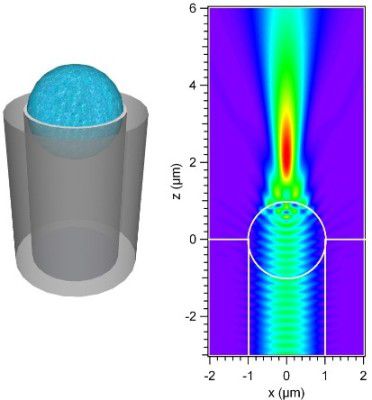Assistant Professor position in Marseille : nanophotonics & biophotonics
The Fresnel Institute at the University of Marseilles (http://www.fresnel.fr), a leading laboratory in the field of Optics, Electromagnetism and Image Processing invites applications for an Associate Professor level position in the field of Biophotonics.
Outstanding candidates with demonstrated excellence in basic research in linear and nonlinear optical microscopy will have high priority. Expertise in nanoparticles fabrication and/or bio-labelling, optical field enhancement with nanostructure for bio-detection will be appreciated. Responsibilities will include conducting basic laboratory research in the Mosaic group http://www.fresnel.fr/mosaic) together with teaching (in French) at undergraduate and graduate levels at the University of Marseilles (Université de Provence) .
More information following this link.
![]()

Latest paper: optical fibers to replace microscopes for single molecule fluorescence detection
Intensity is not enough. Many techniques in optical microscopy take advantage of analysis methods based on single molecule detection events. These measurements provide access to a wide variety of data such as local concentration, structure or mobility of molecules. However, single molecule detection is a challenging task, which requires complex microscope apparatus and is very difficult to take out of the lab.
A mobile endoscope to observe single molecules.
On collaboration with Bordeaux I University (France), my team has recently demonstrated the possibility to detect single fluorescent molecules with an optical fiber. The original system contains a glass microbead at the end of the optical fiber which works as a tiny lens to focus light. The fiber-microbead ensemble is also used to collect the low amount of light emitted by the individual molecules. That way, the bulky microscope is replaced by a remote fiber sensor connected to a miniaturized USB-connected device. This patented technique opens biomedicine and environment monitoring to single molecule analysis.
Reference
H. Aouani, F. Deiss, J. Wenger, P. Ferrand, N. Sojic, H. Rigneault, "Optical-fiber-microsphere for remote fluorescence correlation spectroscopy", Optics Express 17, 18912-18919 (2009)Free download here

OMNT November selection
“Imaging chromophores with undetectable fluorescence by stimulated emission microscopy”, Wei Min, Sijia Lu, Shasha Chong, Rahul Roy, Gary R. Holto, X. Sunney Xie, Nature 461, 1105-1109 (2009)
Fluorescence, that is, spontaneous emission, is generally more sensitive than absorption measurement, and is widely used in optical imaging. However, many chromophores, such as haemoglobin and cytochromes, absorb but have undetectable fluorescence because the spontaneous emission is dominated by their fast non-radiative decay. Yet the detection of their absorption is difficult under a microscope. Here we use stimulated emission, which competes effectively with the nonradiative decay, to make the chromophores detectable...
« Optical Antennas », Palash Bharadwaj, Bradley Deutsch, and Lukas Novotny, Advances in Optics and Photonics 1, 438–483 (2009) doi:10.1364/AOP.1.000438
Optical antennas are an emerging concept in physical optics. Similar to radiowave and microwave antennas, their purpose is to convert the energy of free propagating radiation to localized energy, and vice versa...
« Photonic Nanojets », Alexander Heifetz, Soon-Cheol Kong, Alan V. Sahakian, Allen Taflove, and Vadim Backman, Journal of Computational and Theoretical Nanoscience 6, 1979–1992 (2009).
This paper reviews the substantial body of literature emerging since 2004 concerning photonic nanojets. The photonic nanojet is a narrow, high-intensity, non-evanescent light beam that can propagate over a distance longer than the wavelength λ after emerging from the shadow-side surface of an illuminated lossless dielectric microcylinder or microsphere of diameter larger than λ...Science Festival Marseille 2009
This year, we were celebrating the 400th anniversary of Galileo Galilei's observations with the lens telescope. Therefore, one of our attractions was to re-construct one of these telescopes using magnifying lenses. It's very nice to see that five fold magnifications are readily available with two simple lenses (if you try to do it yourself, put the lens with greater focal length first; the larger the difference in focal lengths, the greater the telescope magnification; actually the magnification equals the ratio of focal lengths). See the pictures below !
Erasmus Mundus Master & Doctorate

The Erasmus Mundus program EUROPHOTONICS financed by the European Community will start in september 2010.
EUROPHOTONICS (see website : http://www.europhotonics.org) is divided in two parts : MASTER and DOCTORATE in the field of PHOTONICS. For the Master, the consortium is composed of the universities of Barcelona (Spain), Karlsruhe (Germany) and Marseille (France). For the Doctorate there is an additional partner : university of Florence (Italy).

Master :
The Master is divided in 4 semesters (2 years) taught in english by the different institutions (see website for details).
- 10 fellowships will be given to students from countries of Category A. Category A fellowships can be awarded to selected candidates, who come from a country other than an eligible applicant country (i.e. a Member State of the European Union, an EEA-EFTA State – Iceland, Norway and Liechtenstein- Turkey, the Western Balkan countries – Albania, Bosnia-Herzegovina, Croatia, Kosovo, the Former Yugoslav Republic of Macedonia, Montenegro and Serbia.-, or Switzerland) , and who are not residents nor have carried out their main activity (studies, work, etc.) for more than a total of 12 months over the last five years in one of these countries.
- 10 fellowships will be given to students of category B (that are not in Category A).
Roughly, the expenses (tuition fees, travel, accomodation, subsistance, insurance) of Catégory A students are entirely covered by the grants.
The amount of the fellowships of Catégory B students are 500 euros/month.
Doctorate :
For the "Doctorate" program, 6 fellowships/year will be given to Category A students and 4 fellowships/year will be given to Category B students. The PhD students will work under a co-tutelle supervision (joint supervision of doctoral studies by at least two universities within the consortium) between one project-leading laboratory and collaborative laboratories (see website).




